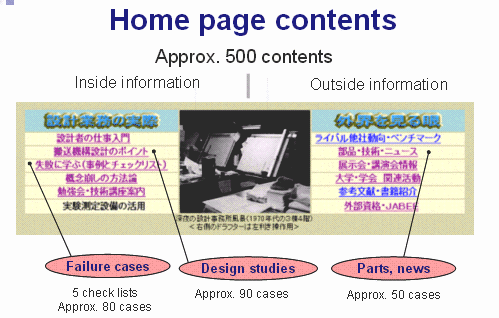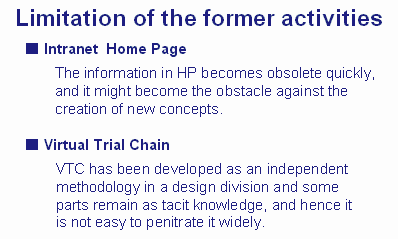| Technical Knowledge Transfer by USIT Application for Paper Handling Mechanism | |
| Kunio Fukatsu (Toshiba Social Automation Systems) | |
| Presented at The Third TRIZ Symposium in Japan, Held at TOSHIBA Kenshu Center, Yokohama, on Aug. 30 - Sept. 1, 2007 | |
| [Posted on Jan. 29, 2008] Under the permission by the Author. |
For going back to Japanese pages, press buttons..
Editor's Note (Toru Nakagawa, Jan. 27, 2008)
The paper posted here was originally presented last August at The Third TRIZ Symposium in Japan
held at TOSHIBA Kenshu Center, Yokohama. The paper was presented in a pleriminary oral session on the first day afternoon.
This paper deals with a general issue in the current Japanese industries and his serious reflection:
- For the purpose of transferring professional knowledge to younger engineers, he has built a design methodology in his own way and also built an intensive intranet home pages of technological knowledge.
- The contents of these knowledge, however, get obsolete very rapidly and can block new idea generation, the Author has found.
- The Author recently learned TRIZ/USIT and has found it useful. And thought that ability of creative problem solving need to be transferred to younger generations.
- The Author demonstrates a case study of USIT problem solving in his professional area but done in an open multi-company training seminar.
I would like to express my thanks to the Author for his nice presentation at the Symposium and for his permission of posting his presentation slides here in the "TRIZ Home Page in Japan".
This page in English contains the followings:
[2] Nakagawa's introduction: Excerpt of my 'Personal Report of Japan TRIZ Symosium 2007'
[3] Presentation slides in PDF (37 slides, 4 slides/page, 761 KB)
)
Whereas in the Japanese page
, we have (1) Extended Abstract (by the Author)
and (2) Presentation slides
.
| Top of this page | Abstract | Nakagawa's introduction | Slides in PDF (761 KB) |
Japanese Extended Abstract |
Japanese Slides PDF |
Japan TRIZ Symposium 2007 (Nakagawa Personal Rept.) |
Japanese page |
[1] Abstract
Technical Knowledge Transfer by USIT Application for
Paper Handling MechanismKunio Fukatsu (Toshiba Social Automation Systems)
Importance of the technical knowledge transfer is widely understood at present when technology and technical talent are largely changing. This paper shows possibility that the USIT is useful in the area of the paper handling mechanism design as a methodology of the technical knowledge transfer.
Authors have been accumulating and releasing the technical knowledge about paper handling mechanism on our company inside homepage. These informations are useful for the improvement of products, but these will become the obstacle for the creation of new conception. For the technical knowledge transfer, the methodology of the technical idea creation is important than the technical knowledge itself.
We had applied original “virtial trial chain” and “destroy the concept” for our product development. As the extension, we knew the TRIZ world which have deep and wide concept. Recently, we are studying the USIT which have the TRIZ concept in the simple process. As the case, USIT application to the paper sacker which was participated in the open seminer is introduced.
[2] Introduction & Review of the Presentation (Toru Nakagawa (OGU), Nov. 14, 2007)
Excerpt from Nakagawa's 'Personal Report of Japan TRIZ Symposium 2007'
(posted on Nov. 18, 2007).
Kunio Fukatsu (Toshiba Social Automation Systems) [8] gave an oral presentation on "Technical Knowledge Transfer by USIT Application for Paper Handling Mechanism". One of the big issues in current Japanese industries is 'how to transfer technical knowledge to younger generations' especially because a large population of engineers in the post-war baby-boom generation are going to retire at the age around 60 and because this particular generation is very active in engineering (Actually many of the Japan TRIZ CB members belong to this generation, though not me). Thus the Author, a senior managing engineer in his company, has been trying to do his best for such transfer by establishing an intranet Home Page and a design methodology. His intranet site is shown in the following slide:

And he has developed a design methodology in his own way in the scheme named VTC (Virtual Trial Chain) having the checklist for brainstorming discussion, as shown in the following two slides:
However the Author feels a serious limitation in these approaches. His slide says as follows:

In such a situation the Author met TRIZ and USIT recently. Last year at the Second TRIZ Symposium he gave a presentation on the extension of 'TRIZ 9-Windows Method' to show/consider 'What follows after next' on the basis of VTC. He also had an experience of attending at a USIT 2-Day Training Seminar instructed by Nakagawa. Thus the Author reports his experiences of solving his own problem together with several engineers coming from different companies.
The problem is to improve a paper stacker system:
The Author reported how the problem was analyzed and solved by use of USIT, in several slides. Sorry but I will skip most of them for saving space here. The following slide shows the analysis of desirable actions for the Ideal system, by using USIT's Particles Method, i.e. an extension of Altshuller's SLP (Smart Little People's Modeling).
The following slide shows the almost-final stage of building up solution concepts. The Author, as an expert in this field of technology, was much impressed with the idea 'G. Switch-back' generated by an non specialist engineer. (*** I, as an non-specialist, personally prefer the idea of 'A. Soft-landing with aerodynamic slowing-down' which I suggested during the seminar.)
Then he drew a detailed sketch of the method, as follows:
In conclusion the Author writes: Transferring the methodology of technical idea creation is important for transferring knowledge to the next generation. USIT has a possibility to support young engineers' idea creation and has a possibility to support transferring knowledge to the next generation.
[3] Presentation Slides
Presentation Slides (in English)
(PDF, 761 KB, 37 slides, 4 slides/page) Click Here.
[4] Links to the Japanese Pages
Pesentation Slides in Japanese
(PDF, 829 KB, 37 slides, 4 slides/page)
| Top of this page | Abstract | Nakagawa's introduction | Slides in PDF (761 KB) |
Japanese Extended Abstract |
Japanese Slides PDF |
Japan TRIZ Symposium 2007 (Nakagawa Personal Rept.) |
Japanese page |
Last updated on Jan. 29, 2008. Access point: Editor: nakagawa@ogu.ac.jp